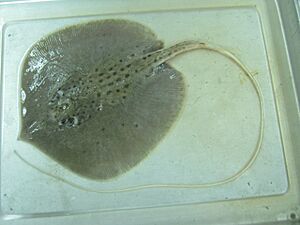White-edge freshwater whipray facts for kids
Quick facts for kids White-edge freshwater whipray |
|
|---|---|
 |
|
| Conservation status | |
| Scientific classification | |
| Genus: |
Fluvitrygon
|
| Species: |
signifer
|
 |
|
| Range of the white-edge freshwater whipray | |
| Synonyms | |
|
Himantura signifer |
|
The white-edge freshwater whipray (Fluvitrygon signifer) is a very rare type of stingray. It lives in four different river systems in Southeast Asia. This ray can grow up to 60 centimeters (about 2 feet) wide. It has a roundish body and a very long, thin tail that looks like a whip.
You can spot this ray by the clear white line around the edge of its brown body. Its tail is also white. It has special skin bumps called dermal denticles along its back. The white-edge freshwater whipray eats small creatures that live on the river bottom. It gives birth to live young. This ray has two long spines on its tail, which can be dangerous if it stings someone.
The International Union for Conservation of Nature (IUCN) says this ray is Endangered. This means it is at high risk of disappearing. It faces big threats from fishing and from its home (habitat) being lost or damaged.
Contents
About the White-Edge Freshwater Whipray
Naming the Whipray
Scientists Leonard Compagno and Tyson Roberts first described the white-edge freshwater whipray in 1982. They gave it the name signifer, which is Latin for "sign-bearing." This name refers to its unique white markings.
The first ray studied was a young female, about 29 centimeters (11 inches) wide. It was found near the Kapuas River in Indonesia. People also call this ray the freshwater stingray or white-rimmed stingray.
Where the Whipray Lives
The white-edge freshwater whipray is one of the few stingrays that lives only in fresh water. It is found in four river systems in Southeast Asia. These are the Kapuas River in Borneo, the Indragiri River in Sumatra, the Perak River in Peninsular Malaysia, and the Chao Phraya River in Thailand.
These rivers are separate today. But long ago, during the Pleistocene Ice Age (about 2.6 million to 12,000 years ago), sea levels were much lower. These rivers might have been connected then. This would have allowed the rays to spread without going into salt water. This ray prefers to live on sandy river bottoms.
What the Whipray Looks Like
The white-edge freshwater whipray has a thin, oval-shaped body. Its body is a bit wider than it is long. The front part of its body narrows to a slightly pointed snout. Its eyes are small, and right behind them are larger holes called spiracles.
Between its nostrils, there is a small skin flap. Its mouth is gently curved. It has many rows of teeth, about 38 to 45 in the upper jaw and 37 to 46 in the lower jaw. These teeth are spaced out and arranged in a pattern. Each tooth has a blunt, cone-shaped top. Males have teeth with higher, jagged edges, while females have lower, blunt edges. There are also small bumps, called papillae, on the floor of its mouth.
The ray's tail is about 3.5 times longer than its body. It has two stinging spines on top. Behind the spines, the tail becomes very thin and whip-like, without any fins. Some recorded spines were about 86 to 87 millimeters (about 3.4 inches) long.
A band of skin along its back, from between its eyes to the tail, is rough. It has small, heart-shaped skin bumps mixed with tiny cone-shaped ones. The tail also has more bumps behind the spines. Young rays have a special "pearl spine" in the middle of their body.
The top of the ray's body is brown, with some darker spots in the middle and on the tail base. It has a white spot between its eye and spiracle. A clear white band runs all around the edge of its body. The underside of the ray is completely white, as is the tail behind the spines. This ray can grow up to 60 centimeters (about 2 feet) wide and possibly over 2 meters (6.5 feet) long.
Life Cycle and Habits
How the Whipray Adapts to Freshwater
Unlike some other freshwater stingrays, the white-edge freshwater whipray can still make urea. This helps it control the salt and water balance in its body. It can even survive in slightly salty water for at least two weeks. This suggests it might have only recently moved into freshwater.
Scientists think that some marine (ocean) rays can successfully live in freshwater because they can make more ascorbic acid (Vitamin C). This helps them deal with the stress of less salt in the water. Also, the ray's ampullae of Lorenzini (special sensors for detecting electric fields) are in between those of ocean rays and other freshwater rays. This might be because it lives in waters with different salt levels.
What the Whipray Eats
The white-edge freshwater whipray mainly eats small creatures that live on the river bottom. These include crustaceans (like crabs), molluscs (like snails), and insect larvae (young insects).
Reproduction and Growth
This stingray gives birth to live young. The baby rays grow inside the mother and are fed by a special "uterine milk." This is common for other stingrays. Newborn rays are about 10 to 12 centimeters (4 to 4.7 inches) wide. Males become ready to reproduce when they are about 21 to 23 centimeters (8 to 9 inches) wide. Females mature when they are about 25 to 26 centimeters (9.8 to 10.2 inches) wide.
Whiprays and Humans
The venomous stings of the white-edge freshwater whipray can be very dangerous to humans. This species is extremely rare. Only about 10 specimens have ever been collected for museums.
Most of the areas where this ray lives have a lot of fishing. The ray is sometimes caught by fish traps, spears, and lines set on the river bottom. It is sold for meat and sometimes for the aquarium trade.
Losing and damaging their homes is an even bigger threat to these rays. This happens because of pollution, logging, and building dams. For example, dams on the Chao Phraya River in Thailand have separated the ray populations. This has reduced their genetic diversity, making them less able to adapt.
Because of these many threats and the lack of connection between the rivers, the International Union for Conservation of Nature (IUCN) has listed the white-edge freshwater whipray as Endangered. The Thai government started a program in the 1990s to breed this and other endangered freshwater stingrays in captivity. However, this program was put on hold by 1996.
Images for kids




